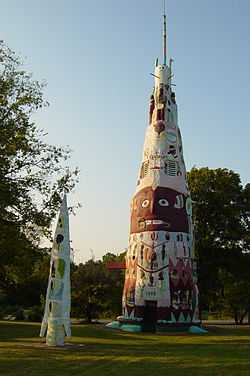Ed Galloway's Totem Pole Park
|
Ed Galloway's Totem Pole Park | |
 | |
|
Ed Galloway's Totem Pole Park | |
 | |
| Nearest city | Foyil, Oklahoma |
|---|---|
| Coordinates | 36°26′14″N 95°26′53″W / 36.43722°N 95.44806°WCoordinates: 36°26′14″N 95°26′53″W / 36.43722°N 95.44806°W |
| Area | 1.4 acres (0.57 ha) |
| Built | 1937 |
| Architect | Nathan Edward Galloway |
| Governing body | Private |
| NRHP Reference # | 99000354[1] |
| Added to NRHP | March 30, 1999 |
Ed Galloway's Totem Pole Park consists of eleven objects and one building on 14 acres (57,000 m²) in Rogers County, Oklahoma. The park is ten miles (16 km) north-east of Claremore and is located 3.5 miles (6 km) east of historic U.S. Route 66 and Foyil. It was added to the National Register of Historic Places on March 30, 1999 and is currently owned and operated by the Rogers County Historical Society and the Foyil Heritage Association. The park's main totem pole is claimed to be the "World’s Largest Concrete Totem Pole."
History and creation
After more than 20 years as a manual arts teacher at the Children’s Home orphanage in Sand Springs, OK, in 1937 Ed Galloway retired and moved his family to a small farm near Foyil. Shortly afterwards he embarked on an ambitious folk art project to create a three-dimensional totem pole using modern building materials. After eleven years of work, Galloway’s totem pole was completed in 1948 and topped out at approximately 90 ft (27 m) in height. The totem pole’s construction took six tons of steel, 28 tons of cement, and 100 tons of sand and rock. The base is 30 ft (9 m) wide and rests on the back of a colourfully painted turtle. It is decorated with approximately 200 bas relief images of brightly colored Native American portraits, symbols, and animal figures that cover the entire totem pole from the base to its pinnacle.
The park also features Galloway’s eleven-sided “Fiddle House” which is supported inside and out by 25 concrete totem poles. It previously housed his hand-carved fiddles, handmade furniture, and bas relief portraits of all of the US Presidents up to JFK. Unfortunately, many of the items in the Fiddle House were stolen in 1970 and never recovered. The park also contains four smaller concrete totems, two ornate concrete picnic tables with animal-form seats, a barbecue, and four sets of animal-form gateposts.
Galloway lived at and worked on the park every day up to his death in 1962 of cancer. Some say that he hoped to use his work to educate young people about Native Americans, but others claim he thought it would be a good thing for youngsters, Boy Scouts in particular, to visit.
Renovation
In the decades following Galloway’s death, all the sculptures began to deteriorate from weather and neglect. In the 1990s, an extensive restoration effort was spearheaded by the Kansas Grassroots Art Association. The outdoor sculptures were restored and repainted, and the Fiddle House was brought back from the brink of collapse and transformed into the Fiddle House Museum and Gift Shop.
References
- ↑ "National Register Information System". National Register of Historic Places. National Park Service. 2009-03-13.
External links
- Ed Galloway's Totem Pole Park - Rogers County Historical Society
- Totem Pole Park info, photos and video on TravelOK.com - Official travel and tourism website for the State of Oklahoma
- Roadside American Report on Ed Galloway's Totem Pole Park